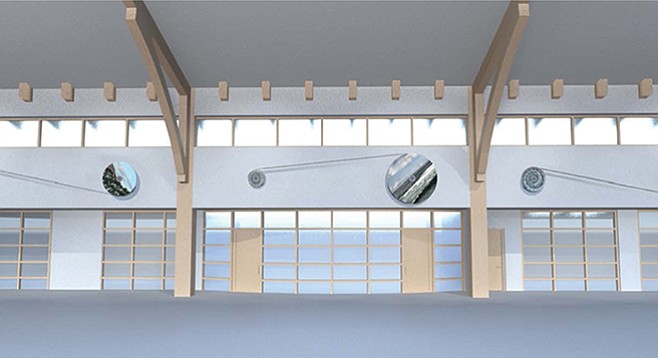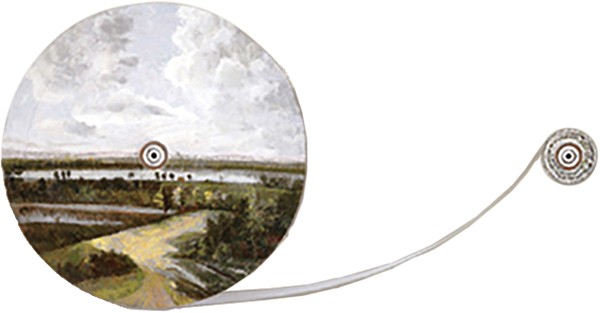 Facebook
Facebook
 X
X
 Instagram
Instagram
 TikTok
TikTok
 Youtube
Youtube

Esoteric may not be the only word to describe the city’s latest tax-financed public arts project, but it could turn out to be the kindest. Numbers recently posted by San Diego mayor Kevin Faulconer’s Open Data project reveals that artist Janet Zweig of Brooklyn, New York, has been awarded a $280,000 commission to install adornment on the long-awaited new Mission Hills library.
According to a description of the installation, the work consists of “three mechanical sculptures that will be visible when entering the library through the main entrance. Each sculpture is a large, approximately four-foot-diameter roll of paper strung from a primary hub to a secondary hub. The secondary hub will contain a motor that very slowly pulls the paper off of the primary hub and onto itself, like an audio tape.” The point? “Each of the three sculptures will function as an ecological ‘clock.’ The pace of the paper’s transfer from one hub to the other will vary for each of the sculptures. The artist will work with local scientists to determine rates of change to the ecologies depicted, such as changes to our aquifers, sea-level and rates of deforestation. Each sculpture’s motor will then be timed to correspond with this scientific data in real-time.”

Zweig is noted on the national public art circuit for her eccentric installations. In Saint Louis, she employed lumber from demolished houses to create a backward sign on an overpass near that city’s Maplewood neighborhood, correctly viewable only in the rear-view mirrors of passing motorists. In her home town of Milwaukee, Zweig created Pedestrian Drama, featuring a series of high-tech viewing stations. “As pedestrians approach the kiosks, installed on electrical poles, the artworks will activate and begin flapping. Looking inside one of the windows, onlookers will see short scenes of pedestrian encounters,” reported the Milwaukee Journal-Sentinel in August 2011. “The project became briefly controversial in April of 2009 when some city aldermen were unimpressed by a presentation by members of the Department of Public Works staff who shared preliminary schematic designs.”
A forthcoming interactive piece by Zweig at a public library in Boise, Idaho, “will allow people to write poetry, flash fiction or other literary forms on a typewriter attached to a giant roll of sculpted paper,” the Idaho Statesman reported this month. “The writings will be on display and logged into an archive that the city will keep in perpetuity.”
In January of this year, the Westmoreland Museum of American Art in Greensburg, Pennsylvania, required Zweig to modify a project after the Norfolk Southern Railway refused to cut down trees on its property that blocked the sight of the museum from nearby railroad overpasses. “She originally proposed two ‘anamorphic illusions,’ sculptures that appear random and haphazard when viewed from most angles,” said the Pittsburgh Tribune-Review. “Now she must come up with a new concept that takes the low visibility from the bridges into account.”


Esoteric may not be the only word to describe the city’s latest tax-financed public arts project, but it could turn out to be the kindest. Numbers recently posted by San Diego mayor Kevin Faulconer’s Open Data project reveals that artist Janet Zweig of Brooklyn, New York, has been awarded a $280,000 commission to install adornment on the long-awaited new Mission Hills library.
According to a description of the installation, the work consists of “three mechanical sculptures that will be visible when entering the library through the main entrance. Each sculpture is a large, approximately four-foot-diameter roll of paper strung from a primary hub to a secondary hub. The secondary hub will contain a motor that very slowly pulls the paper off of the primary hub and onto itself, like an audio tape.” The point? “Each of the three sculptures will function as an ecological ‘clock.’ The pace of the paper’s transfer from one hub to the other will vary for each of the sculptures. The artist will work with local scientists to determine rates of change to the ecologies depicted, such as changes to our aquifers, sea-level and rates of deforestation. Each sculpture’s motor will then be timed to correspond with this scientific data in real-time.”

Zweig is noted on the national public art circuit for her eccentric installations. In Saint Louis, she employed lumber from demolished houses to create a backward sign on an overpass near that city’s Maplewood neighborhood, correctly viewable only in the rear-view mirrors of passing motorists. In her home town of Milwaukee, Zweig created Pedestrian Drama, featuring a series of high-tech viewing stations. “As pedestrians approach the kiosks, installed on electrical poles, the artworks will activate and begin flapping. Looking inside one of the windows, onlookers will see short scenes of pedestrian encounters,” reported the Milwaukee Journal-Sentinel in August 2011. “The project became briefly controversial in April of 2009 when some city aldermen were unimpressed by a presentation by members of the Department of Public Works staff who shared preliminary schematic designs.”
A forthcoming interactive piece by Zweig at a public library in Boise, Idaho, “will allow people to write poetry, flash fiction or other literary forms on a typewriter attached to a giant roll of sculpted paper,” the Idaho Statesman reported this month. “The writings will be on display and logged into an archive that the city will keep in perpetuity.”
In January of this year, the Westmoreland Museum of American Art in Greensburg, Pennsylvania, required Zweig to modify a project after the Norfolk Southern Railway refused to cut down trees on its property that blocked the sight of the museum from nearby railroad overpasses. “She originally proposed two ‘anamorphic illusions,’ sculptures that appear random and haphazard when viewed from most angles,” said the Pittsburgh Tribune-Review. “Now she must come up with a new concept that takes the low visibility from the bridges into account.”
Comments